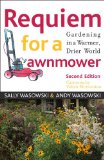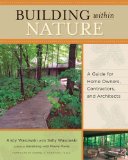| Stories from a natural landscaping pioneer. |
| ABOUT US START IDEAS DO LESS USEFUL PLANTS PROJECTS VIEWS RESOURCES TOPICS |
|
|
|||
In her 1992 book Requiem for a Lawnmower Wasowski is just as outspoken and just as passionate about native landscapes today, a decade and a dozen books after Requiem My eyes misted (I imagine hers did too, though I couldn't see them from across the packed meeting room) as she described the experience of finally finding a prairie taller than a person. It was like a wall of grasses and flowers, she said. She stepped into it so her husband could get a photo, and though she was worried about stepping on the crowns of plants and damaging them, she found there was plenty of room for her feet between the plants. After she had backed up about ten feet, she couldn't see her husband anymore. He snapped a picture of her hand waving above the stalks and flowers. Wasowski's moving narrative was interspersed with sobering facts about the extent to which our native American landscape has been (and continues to be) destroyed. She made three main points. First, people must become more familiar with native plants. A friend of Wasowski's was installing a prairie at a public building. The employees passed her each day as she worked, and later when the plants had established and she was tending them. One woman in particular made a point of saying hello at the beginning of the project and asking questions about it. Wasowski's friend knew that many people who are used to having a more traditional landscape tend to think native landscapes are not beautiful, so every time this woman stopped to check on her progress, she introduced a particular plant that was in bloom, or had put up a seedhead, or had another interesting feature. Finally, one day the woman told her, "I wasn't sure this was a good idea at the beginning, because I like a nice neat lawn, but now that I know some of the plants, I think it's beautiful." Familiarity is crucial to appreciating native landscapes, says Wasowski. The prairie at first is "a sea of strange faces" that we only grow to love as they become familiar. The native plants were "strange faces" to the European settlers, who brought their own plant friends with them - the useful ones and the decoratives as well. I can understand that they wanted to see familiar faces in their landscapes, but like Wasowski, I think it's a shame that, so many generations later, we go on ignoring the natives, especially given that, by and large, they grow better than the migrants here (it is their home), and they also have medicinal and culinary uses to us and to the animals, who often can't recognize—and therefore don't use—the foreign plants. This brings us to Wasowski's second point: we must make it easier for people to use native plants. It can take a lot of research and effort to learn a plant's name, let alone to understand how it fits into the environment. Almost everywhere in the country, says Wasowski, there's a species of needlegrass. What good is it? No one could tell her, not even the ranchers. Wasowski went to visit a herd of buffalo. One of the cows made sure she was watching, then yanked up a clump of needlegrass. Its roots were hanging down on one side of the cow's mouth, and its needles were pointing out every which way on the other. While Wasowski stared, the buffalo chewed on the clump for several minutes, rotating it until all the needles were aligned in one direction, then she "sucked the whole thing down in one gulp." Wasowski concluded that needlegrass was useful after all: buffalo ate it. Her latest book, Gardening with Prairie Plants The final point of Wasowski's speech hinted at a change of heart from her earlier written sentiments; due to the urgency of the situation, she said, we simply can't afford to be snobbish about native plants. Debates rage among natural landscaping proponents. One controversial issue is that of genotype. A plant is assumed to be genetically adapted to the specific place in which it grows. Populations of a species found in different areas can show marked differences in easily observable traits like flower or leaf color and moisture preference. What other difference exist in their less obvious traits? Purists believe that the variation among genotypes from different locales should be preserved. If you're planning to use natives, in other words, you need to find descendents of your local plants. We cannot afford this purist approach, says Wasowski. The most important task right now is to save the dwindling populations of native plants, to introduce them to the public and encourage their widespread use. To complicate the issue by telling people they shouldn't plant natives except from certain few sources will drastically reduce the number of natives planted. Her latest book offers information that will allow people to include native prairie plants among their traditional garden plants as well as helping those who wish to recreate or restore a prairie, but her broader focus remains on the latter, just as it was when she wrote Requiem. She closed her talk by urging the Wild Ones to continue their important work of restoring and recreating natural landscapes. "We're at a crossroads now," she said. We have all the puzzle pieces - microrhizae, native plants, pollinators, and even some remnants of the original ecosystems. We must fit them together while we still can. Due to the rate of development and population growth, "we may not have them much longer." |
Editor's Note : I want to thank Joy, who prompted me to finish this article when she wrote this note praising Sally and Andy Wasowski: "They are virtually living legends and their books are truly gardening bibles to me, especially Native Texas Plants... Gardening with Prairie Plants is just incredible. It covers all areas of the U. S. that were or are prairie. Also Sally wrote a book called Requiem for a Lawnmower published back in 1992 about the very same issues you write about." Investigate Sally Wasowski's Gardening with Prairie Plants: How to Create Beautiful Native Landscapes :  Review and excerpt for sale at Amazon Other recommended books by Sally Wasowski :  Reissued in 2004, this gardener's storybook shares Sally's early experiences with gardening naturalistically. for sale at Amazon  Did you realize it's possible to construct a home with only a ten-foot-wide "swath of destruction" around it, instead of leveling the lot first? Sally and Andy Wasowski can help you do it. for sale at Amazon |
||
|
Thanks for visiting http://www.LessLawn.com! All site contents © 2001-2013 Evelyn J. Hadden, except where noted. All rights reserved. |